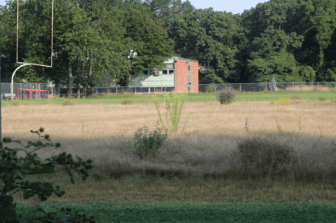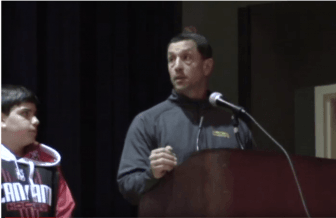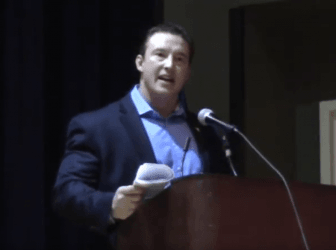Thursday’s Board of Education meeting is available to view online in its five-hour entirety.
Divided BOE Votes on Combo of Engineered Natural Grass and Artificial Turf at Central Middle School
There was passionate testimony from both sides over artificial turf vs real grass fields at Central Middle School, which was a decision item on the agenda.
Currently no public middle school in Greenwich has a turf field.

Western Middle School’s fields have been out of use since contamination was discovered in 2016. Photo: Leslie Yager
The meeting was held at Western Middle School, an irony that was not lost on Gordon Beinstein, principal at the school that has not had access to its playing fields since contamination was discovered in 2016.
“I want to remind all of you that your debate is a luxury we at Western do not enjoy,” Beinstein said. “At the glacial place with which this is moving through the system I fear our fields will never open and will be Memorial Fields. …. Enough. Our kids deserve better.”
Central Middle School PE teacher Nancy Tarantino said she had transferred from Eastern Middle School despite warnings about the fields constantly being wet.
“I believed it couldn’t be that bad,” she recalled, adding, “Any time there is any precipitation on the field it becomes unusable.”
She said teachers modify lessons and the inconsistent of delivery of curriculum is unfair to students.
“We use the tennis courts to accommodate 580+ students,” she said.
Three young children testified in favor of natural grass. Dominick Casamassima said artificial turf contains elements that harm students, and that turf would have a negative effect on the climate and change levels of CO2 in the atmosphere.
“The loss of plants would reduce the amount of carbon dioxide absorbed,” he said. “In addition it would deprive many animals of their homes, and put dangerous metals such as lead, cadmium and chromium into the environment.”

Phil Tarantino testifies in favor of synthetic turf at the Feb 20 Board of Education meeting. Feb 20, 2020
Western PE Teacher Phil Tarantino, who is a former GHS baseball coach, pointed out that middle school students already play on artificial turf off campus.
“There’s turf fields everywhere in Greenwich including GHS, Brunswick, GCDS, Sacred Heart, Cos Cob Park, and the Greenwich Boys & Girls Club,” he said, adding that the field in Cos Cob Park has become the de facto home field for Western, where they play Central, and that Central teams play against private schools on their turf fields.
Hillside Rd resident Elizabeth Dempsey pointed out that turf fields require regular disinfecting. “Kids slide, especially on turf. They get bloody,” she said.
CMS principal Tom Healy who is also a coach and parent of an athlete at CMS, said middle schoolers tend to play organized sports, which increases the demand for fields, but that the community is divided.
“I know it’s a community field, and is rented the most out of any field. We’re happy to host with the appropriate surface to withstand all of that,” Healy said.
 RTM member Carl Higbie whose district includes Central Middle School, said his own children will attend the Central and would debunk neighbors who oppose turf on health grounds.
RTM member Carl Higbie whose district includes Central Middle School, said his own children will attend the Central and would debunk neighbors who oppose turf on health grounds.
“You don’t care about the kids, that’s not what you’re doing,” he said. “When you tell me it’s not environmental not friendly and you’re worried about the risk and health benefits to our children. That’s hogwash.”
Higbie went on to list the authors of an op ed opposing turf by name and question their motives.
“You all live within a 9 iron distance to the field. You don’t care about the kids. You want to lose your personal back yard. That’s disingenuous. It’s sad, dishonest and disgusting,” he said to loud applause.
Still there was loud applause for speakers defending natural grass.
Warren Silver, who was one of the neighbors Higbie described as disingenuous, said he suspected that the BOE planned to have GHS teams use a turf field at CMS.
He also noted that the petition in favor of turf had fewer than 700 signatures, and didn’t require people to be from residents of at least 18, whereas a petition against turf had a combined online and offlie total of 2,400 signatures.
“Artificial turf has carcinogens and is bad for the kids. Period,” he said.
Laura Kostin, a CMS parent, said the existing grass field might look better if outside, for-profit groups did not rent them so often, and the town should prioritize users.
“Carmel Academy is closing and they have fields,” she said. “We have space in this town, I suggest we use it.”
Patricia Taylor, outreach director at Environment and Human Health Inc, was one of several experts who testified against artificial turf.
“By installing artificial fields you will be exposing your children and adolescent athletes daily to multiple chemicals of concern, including carcinogens, Endocrine disruptors and PFAs,” Taylor said.
Neuroscientist Sarah Evans PhD, an assistant professor of Environmental Medicine and Public Health at Mt Sinai, spoke on behalf of a collective of physicians and independent research scientists, who concluded that studies do not adequately demonstrate the safety of these products.
Former State Rep Mike Bocchino said there are no studies proving turf harms children.
“This is like a reunion with these PhDs and doctors. We had this debate in Hartford. …Not one doctor or scientist could tell us of one case that was tied, without a doubt, that cancer was caused because of a particular athletic field,” Bocchino said. “It never happened, but we go with the theater of, ‘God we’re going to get cancer from this artificial turf.'” – Mike Bocchino, former State Rep
Jeff Cordulak, former Audubon Greenwich director, said he has trained 400 landscapers to care for real grass lawns and fields organically.
“Have you all heard about drug resistant diseases that can be found and thrive on fake turf fields?” he asked. “Have you assessed and set standards about when to stop summer time play above 80° where second and third degree burns send kids to emergency rooms? Have you hired an organic specialist to bid on a natural field? Make sure you get multiple bids on grass fields.”
Cordulak argued that with some effort, the wet fields would be in better condition.
“Have you thought, ‘My gosh, these terrible fields that have no drainage have already been putting up with 50 hours of use?’ he asked. “Imagine if you get them a little treatment. Give the some drainage, give them a little food and the people to take care of them, to have pride in them.”
Around midnight the BOE voted, but not for any of the three options most residents were familiar with.
Instead they voted on a Option 4, which is similar to the hybrid Option 3 but provides a full size engineered grass baseball field as well as an artificial turf multipurpose field.
Both fields will have proper drainage. The projected cost, with escalations, is $2,265,000. (Options 1-3 did not include escalations.)
A motion to approve Option 4 was made by BOE member Joe Kelly, former longtime rugby coach at GHS, who said that while discussion from opponents of turf focused on the health of children, turf enabled kids to “get out and run around.”
“With turf the kids get a full workout,” he said. “One the ruby program I ran, we didn’t just take the top athletes, we took the kids who were not athletes. These kids would otherwise be playing Grand Theft Auto or a video game that would stop them from getting out there and running around.”

Peter Sherr balked at option 4. “I don’t know what Option 4 is. Some of you have been cooking this up,” he said.
BOE chair Peter Bernstein disagreed. “The superintendent sent it to us last week. It’s been posted.”
Mr. Sherr asked what infill would be used with Pption 4, and Mr. Bernstein replied it would be Envirofill, which is coated sand.
Project manager from Milone & MacBroom Kevin Fuselier said option 4 came about after his company’s last presentation, and that Option 3 – the hybrid option – eliminated the baseball diamond, which was unacceptable.
“We went back to the drawing board,” he said, explaining that Option 4 costs a bit more because it is bigger.
“Option 4 pushes really pushes the synthetic portion as far as we could to the west and incorporates enough size to accommodate a softball diamond.
It would have a backstop and full regulation softball field, and then accommodates a full natural grass baseball field, with a slightly truncated right field so left handed hitters will enjoy this.”
– Kevin Fuselier, Milone & MacBroom
Fuselier said Option 4 also includes 120,000 sq ft of natural grass. “It’ll be an engineered natural grass system with under drainage and amendments to the soil because we know drainage is a problem here. By lifting we will improve it and, as everyone said, it’s a compromise on surface materials.”
Sherr noted the difference between Option 1 (engineered grass with a cost of $1.1 million) and Option 4 (combination of turf and natural grass at $2.3 million).
He said he was concerned the turf might have to be ripped out if the district rebuilds Central Middle School. “Once we lay it down, we can’t reuse the carpet.”
Citing the master plan, Mr. Sherr said, “We were told the worst building in the district is Central Middle School. It needs to be replaced. It shouldn’t be renovated….the real problem is with Parks & Rec, not with the Board of Education.”
Superintendent Dr. Jones said staff works well with Parks & Rec, and that the all natural grass option would not provide enough play hours to enough to meet need.
“Going with all grass – even with a grounds keeper full time – if we go over 25 hours, which just the school alone will do – we’re going to invest a million dollars and we’ll be telling the community, ‘Oh by the way you can’t use it.’
The reality is keeping people off of it will be a challenge. You’re going to have a million dollars you invested that will probably be a mess by the end of the year.” – Dr. Toni Jones, Greenwich Schools superintendent
Mr. Sherr said Option 4 represented an additional $1.3 million over the $1million in the First Selectman’s proposed budget.
First Selectman Fred Camillo said he favored natural grass for on the grounds that children at that age don’t have a choice.
“We want to see if actually drainage on the (engineered) grass field is going to work. If we commit to it and at the end of the year it didn’t work, we’re right back to where we were. Basically with a field of mud.” – Peter Bernstein, BOE chair
Mr. Bernstein said Option 4 because provides the most flexibility.
“When we tear the building down, it still gives the ability to move the building around,” he said. “I do not want to put up a gate around this (grass) field and tell people, ‘It’s resting right now.'”
Bernstein said the Board spent time last year talking to Parks & Rec about their level of service, which he said had diminished in the 20 years that department has been responsible for school fields.
“I worry about Parks & Rec’s ability to actually do the work that was sent to them,” Bernstein said adding that last year, then superintendent Ralph Mayo tried encourage Parks & Rec to increase levels of service.
“We basically got stonewalled at the end of the year because they knew the clock was running out. It went nowhere,” Bernstein added. “Out of the 22 positions send over to Parks & Rec, two are left. Every year they basically cut the positions that serve the fields.”
He said the best fields maintained by Parks & Rec are the ones that department rents out. He said that for example, at Julian Curtiss School the baseball field that is rented out is pristine, and the one for students has a weed infield.
Meghan Olsson said she understood both sides and Option 4 was the best option.
Christina Downey said, “Our job is about the schools, not the other organizations, and the school personnel have repeatedly said we need a playable outside area.”
Karen Hirsch said she was torn but the best option was the 50-50 afforded by Option 4. She said if CMS were to be rebuilt in 10 years, that would roughly coincide with the time the turf would need to be replaced anyway.
Karen Kowalski said she the engineered real grass with proper drainage field should be given a chance to work.
After Mr. Kelly madethe motion to approve Option4, it was seconded by Kathleen Stowe.
The vote was six in favor, one opposed (Karen Kowalski), and one abstention (Peter Sherr.)
On Monday Warren Silver and Carl Higbie shared their thoughts after having the weekend to reflect.
“Money is a powerful motivator,” Mr. Silver said in an email. “It was clear that the primary proponents in favor of artificial turf were sports organizations that benefit financially due to the good graces of the town. The negative impact of artificial turf on young children’s health or the environment was not a consideration.”
In his follow up quote, Higbie said in an email, “My children will attend central middle school in the not to distant future and I want them to have a field to play on. It is quite pathetic that the opponents of turf are using false claims of negative health effects to hide behind their true intention which is to keep CMS’s field as unused as possible to benefit their personal enjoyment as their taxpayer funded back yard. To date they have spoken in broad generalities, and no one has been able to provide a single specific case of someone being harmed by modern turf.”